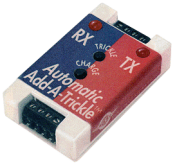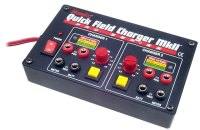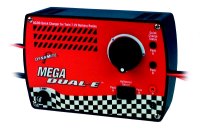Charging Systems
by Jim Ewing
Great Hobbies Inc
There are many types of charging and cycling systems on the market today and the choices and features may seem overwhelming for the average modeller. We hope we can clear up some of the confusion with our discussion on the various features to consider when purchasing a charging system.
Please note: that the following applies primarily to NiCd and NiMH batteries and not to the newer Lithium packs.
 Trickle Charging
Trickle Charging
Charging at a low enough current such that the charger may be left on the battery indefinitely is called trickle charging. You would not want to use a trickle charger alone as it would take a long time to bring the battery up to full charge. Trickle chargers are generally used in conjunction with either a system charger or fast/peak charger to maintain the battery after a normal charge and may even come as part of a more sophisticated charging system circuitry. A typical trickle charge rate would be 1/100 of the battery's capacity.
Overnight Charging
The NiCd charger that comes with a typical radio control system is referred to as a "system charger" and is designed to charge the battery pack at a slow or "overnight" charge rate. This is quite standard for NiCds and charge times for these are between 10 and 14 hours at a rate of 1/10 the battery pack's capacity. All NiCds are designed to be charged with this type of charger. Please note that if you upgrade your radio system to a higher capacity battery pack, you should also upgrade your system charger or be aware that it is going to take longer to charge the pack with the original charger.
Fast Charging
Fast charging is used when you want to charge your batteries in a hurry such as for packs that power an electric model.
 There are several factors that must be considered when fast charging. To fast charge you must supply a high amount of current through the pack. High amounts of current also produce heat which can be an enemy of your battery if not managed properly. A certain amount of heat will be generated and is acceptable during the fast charge, however, once the battery becomes fully charged continuing the high rate of current will most certainly damage your battery.
There are several factors that must be considered when fast charging. To fast charge you must supply a high amount of current through the pack. High amounts of current also produce heat which can be an enemy of your battery if not managed properly. A certain amount of heat will be generated and is acceptable during the fast charge, however, once the battery becomes fully charged continuing the high rate of current will most certainly damage your battery.
Some NiCds are better suited to fast charging than others. Sanyo's "R" type cell are designed for fast charging and handle the heat better.
There are two basic types of chargers that are used for fast charging and these are the timed charger and the peak detection charger.
Timed Charging
Timed charging is a method of fast charging where the charger is on a mechanical timer so that once the timer runs out, the charge is shut off. Typical fast charge times are of 15 to 20 minutes.
 The timer cannot guarantee that the battery will not be overcharged, however. This is especially true if the battery is put on the charger when it is still carrying a partial charge. The best way to handle this is to fully discharge the battery before the charger is turned on so you know the battery will require a full charge and the charge time can be set accordingly. Some timer type chargers come with a discharge circuit already built-in just for this purpose.
The timer cannot guarantee that the battery will not be overcharged, however. This is especially true if the battery is put on the charger when it is still carrying a partial charge. The best way to handle this is to fully discharge the battery before the charger is turned on so you know the battery will require a full charge and the charge time can be set accordingly. Some timer type chargers come with a discharge circuit already built-in just for this purpose.
Peak Detection Chargers
An easier and more foolproof method for charging is using a peak detection charger.
An interesting peculiarity about NiCds is that during the charging process, the voltage of the cells will increase until they are fully charged. At that time, the voltage will then back off slightly. Modern circuitry makes use of this nice little feature, detecting when the voltage starts to drop and thus deactivating the charge current. This gives you a fully charged battery without going into overcharge and heating up.
Cycling
Although controversial, it is believed by many that NiCd batteries have one bad characteristic in that they can develop a memory. If a NiCd battery is repeatedly fully charged and then used an amount that is less than full capacity (let's say you charge and regularly have three or four flights in a session), after a period of time, it may not be able to deliver any more than the capacity frequently used. This is called NiCd memory.
 One way too avoid this "memory", is to cycle the batteries. Cycling is where the battery is fully discharged under controlled conditions and then recharged. By fully discharging the pack in this way every so often, the cells in the pack will not develop memory and will remain at maximum possible capacity. Devices that do this function are called battery cyclers.
One way too avoid this "memory", is to cycle the batteries. Cycling is where the battery is fully discharged under controlled conditions and then recharged. By fully discharging the pack in this way every so often, the cells in the pack will not develop memory and will remain at maximum possible capacity. Devices that do this function are called battery cyclers.
Battery cyclers may come with a variety of features geared to the charging, discharging, testing and conditioning of NiCd batteries. Many have digital readouts which can tell you the pack voltage, the discharge time, and the capacity of the pack. Most will handle your receiver and transmitter packs simultaneously and with some you may even be able to select the number of cells to cycle and the amount of current to draw during discharge.
12VDC and 110VAC Operation
Most chargers on the market are going to operate from either 12VDC or 110VAC or both. If you are going to be charging in the field away from house current, you will definitely want 12VDC capability. If you are going to be charging where you have access to AC power and don't necessarily have regular access to a car battery, then be sure your chosen charger has 110VAC capability.
12V power supplies are available so that you can use 12VDC only chargers from 110VAC house current. Be sure to select one that has enough current to supply the charger and that it is well filtered for pure DC output, especially if it is powering a peak detection charger. Some chargers may "false peak" and throw the battery off charge from impurities in its power supply.
If you are charging 8 or more cell packs you will have to either use a 110VAC charger or a 12VDC charger that has a voltage boosting circuitry to get a full charge.
Summing up . . .
I hope this has helped eliminate some of the confusion with regard to the different chargers and the various features found in them. If you would like to know more about choosing the correct charger , please give our Tech Line a call. Our technicians will be more than happy to help you.
To better understand batteries and their operation, please read the companion article on Maintaining Your Batteries which can be found in our R/C catalog and also on our web site under "Tech Talk" in the R/C section. Another great article to refer to, only found on our web site, is NiCd Battery Seminar by Red Scholefield, Red's R/C Battery Clinic.

